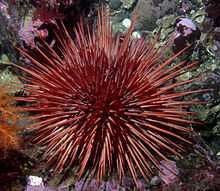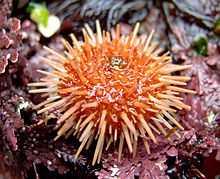Red sea urchin
| Red sea urchin | |
|---|---|
 | |
| Scientific classification | |
| Kingdom: | Animalia |
| Phylum: | Echinodermata |
| Class: | Echinoidea |
| Order: | Echinoida |
| Family: | Strongylocentrotidae |
| Genus: | Mesocentrotus |
| Species: | M. franciscanus |
| Binomial name | |
| Mesocentrotus franciscanus (Aggasiz, 1863) | |
| Synonyms | |
| |
The red sea urchin (Mesocentrotus franciscanus)[1] is a sea urchin found in the Pacific Ocean from Alaska to Baja California. It lives in shallow waters from the low-tide line to 90 m (300 ft) deep, and is typically found on rocky shores sheltered from extreme wave action.
Description

A sea urchin's spherical body is completely covered by sharp spines that can grow up to 8 cm (3.1 in). These spines grow on a hard shell called the "test", which encloses the animal. The oldest ones have been measured to be around 19 cm (7.5 in) in diameter. It can vary in color from red to dark burgundy. Rarely, albino specimens are found. A sea urchin has no visible eyes or legs. It has a mouth located on its underside, which is surrounded by five teeth. During larval development, the body of a sea urchin transitions from bilateral to radial symmetry.
This bilaterally symmetrical larva, called an echinopluteus, subsequently develops a type of pentaradiate symmetry that characterises echinoderms. It crawls very slowly over the sea bottom using its spines as stilts, with the help of its tube feet. Scattered among its spines are rows of tiny tube feet with suckers that help it to move and stick to the sea floor.
Feeding habits
This animal has a mouth with special jaws (Aristotle's lantern) located on the bottom (oral) surface. Its preferred diet is seaweeds, kelp and algae, which it scrapes off and tears up from the sea floor. During larval development, urchins use bands of cilia to capture food from the water column.[2] Red sea urchins found in the channel adjacent to San Juan Island have been found to live a uniquely sedentary lifestyle with the heavy currents bringing an abundance of food.[3]
Behavior and reproduction
Sea urchins are often found living in clumps from five to ten. They have the ability to regenerate lost spines. Lifespan often exceeds 30 years, and scientists have found some specimens to be over 200 years old.[4]
Spawning peaks between June and September. Eggs are fertilized externally while they float in the ocean, and planktonic larvae remain in the water column for about a month before settling on the bottom of the sea floor, where they undergo metamorphosis into juvenile urchins. These juveniles use chemical cues to locate adults. Although juveniles are found almost exclusively under aggregated adults, the adults and juveniles are not directly related.
References
- ↑ Agassiz, A. "Mesocentrotus franciscanus". WoRMS. Retrieved 28 April 2014.
- ↑ Richard R. Strathmann (1971). "The feeding behavior of planktotrophic echinoderm larvae: mechanisms, regulation, and rates of suspension feeding". Journal of Experimental Marine Biology and Ecology 6 (2): 109–160. doi:10.1016/0022-0981(71)90054-2.
- ↑ Whippo, R; Lowe, A; Britton-Simmons, K (2011). "Effects of the Red Sea Urchin on Benthic Invertebrate Communities: A Link to Spatial Subsidies". In: Pollock NW, ed. Diving for Science 2011. Proceedings of the American Academy of Underwater Sciences 30th Symposium. Dauphin Island, AL: AAUS; 2011. Retrieved 2013-03-18.
- ↑ Thomas A. Ebert & John R. Southon (2003). "Red sea urchins (Strongylocentrotus franciscanus) can live over 100 years: confirmation with A-bomb 14carbon" (PDF). Fishery Bulletin 101 (4): 915–922.
External links
| Wikimedia Commons has media related to Strongylocentrotus franciscanus. |
| Wikispecies has information related to: Strongylocentrotus franciscanus |